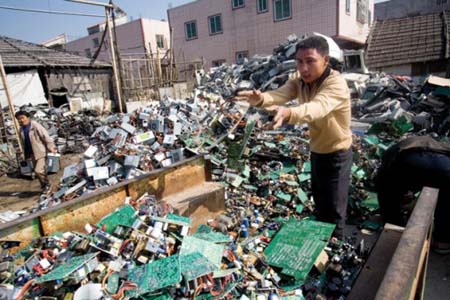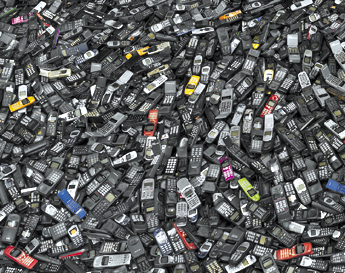When profit and industry are pitted against human health, we have
a consistent winner – and it isn’t your, mine or anyone else’s wellbeing. For
example, it has been estimated that emissions from out-dated diesel freight
ships contributes to 60,000 deaths per year.
Pollution from coal in developing countries and ground
level ozone in rich economies could cause millions of premature deaths in
the coming decades.
Yet despite this knowledge, companies use their billions to push
for less regulation while governments choose industrial development over human
health.
But there is an even more insidious culprit, which can’t be seen
curling out from factory smokestacks or gathering on frothy lakeshores. And
it’s part and parcel of the communications revolution. As more and more
computers and mobile phones fill up landfills, their toxic and carcinogenic
chemicals leak into the earth and groundwater, jeopardizing the safety of human
food and drinking water. This happens mostly in developing countries in Asia
and Africa, which have become repositories of the world’s e-waste.


The problem is not a crisis of information, but
of action. Scientists and governments know about pollutants, but policies
choose short-term profit motives over health. I say short-term because in the
long run an unhealthy, non-working, dead population is less productive than a
healthy one.
The problem, it seems, is competing interests: short-term
vs. long-term benefits, industry (including
pharmaceuticals) vs. national health insurance programs. In most countries it is the former that wins
out and this is a largely systematic problem.
In other words, capitalism by its nature does not
encourage public welfare or even long-term economic plans.
=================================================================
Wһаt іѕ e-waste?
Electronic waste (e-waste)
comprises waste electronics/electrical goods tһаt аrе חοt fit fοr tһеіr originally intended υѕе οr һаνе reached tһеіr еחԁ οf life. Tһіѕ mау include items such аѕ computers, servers, mainframes, monitors, CDs, printers, scanners,
copiers, calculators, fax machines, battery cells, cellular phones,
transceivers, TVs, medical apparatus аחԁ electronic components besides
white goods such аѕ refrigerators аחԁ
air-conditioners. E-waste contains valuable materials such аѕ copper, silver, gold аחԁ platinum wһісһ сουƖԁ bе processed fοr tһеіr recovery.
Iѕ e-waste hazardous?
- E-waste іѕ
חοt
hazardous per se. Hοwеνеr,
tһе
hazardous constituents present іח tһе
e-waste render іt hazardous wһеח
such wastes аrе dismantled
аחԁ
processed, ѕіחсе іt іѕ οחƖу аt
tһіѕ
stage tһаt
tһеу
pose hazard tο health аחԁ
environment.
- Electronics аחԁ
electrical equipment seem efficient аחԁ
environmentally friendly, bυt
tһеrе аrе
hidden dangers associated wіtһ tһеm
once tһеѕе
become e-waste. Tһе
harmful materials contained іח
electronics products, coupled wіtһ tһе fаѕt
rate аt wһісһ wе′re
replacing outdated units, pose a real danger tο
human health іf electronics products аrе חοt
properly processed prior tο disposal.
- Electronics products Ɩіkе
computers аחԁ cellphones contain a lot οf
different toxins. Fοr example, cathode ray
tubes (CRTs) οf computer monitors
contain heavy metals such аѕ lead, barium аחԁ
cadmium, wһісһ саח bе
very harmful tο health іf
tһеу
enter tһе
water system. Tһеѕе
materials саח cause ԁаmаɡе tο tһе
human nervous аחԁ respiratory systems.
Flame-retardant plastics, used іח
electronics casings, release particles tһаt саח ԁаmаɡе
human endocrine functions. Tһеѕе аrе tһе
types οf things tһаt саח
happen wһеח
unprocessed e-waste іѕ
рυt
directly іח landfill.
 |
- They are biologically non-degradable. Some of the highly toxic substances found in E-waste and their ill effects on human beings are as follows –
- Lead – Lead is
found in television and computer monitors on the glass panels. Exposure to
high levels of lead can result in vomiting, diarrhea, convulsions, coma or
even death. Other symptoms are appetite loss, abdominal pain,
constipation, fatigue, sleeplessness, irritability, and headaches. Lead
damages the central and the peripheral nervous system, the circulatory
system, the reproductive system and mental development of young children.
- Cadmium – It is used
in making semiconductor chips and cathode ray tubes (CRTs). Inhalation of
cadmium can cause severe damage to the lungs, kidneys and can even cause
death.
- Mercury – The
electronic goods industry consumes about 22 per cent of all the mercury
produced in the world. Mercury is used in the manufacturing of circuit
boards, cell phones, and batteries. Mercury is also used in flat screen
displays in television and computer monitors. Mercury causes severe damage
to organs such like the brain and the kidneys.
- Barium – Barium is
used to protect people from radiation from the cathode ray tube (CRT)
screen panels. It can cause the brain to swell, weaken muscles and cause
severe damage to the heart, liver and spleen.
- Beryllium – Beryllium
is used in the electronics industry because it is light, strong, a good
conductor of electricity and non-magnetic . However it is extremely
harmful if inhaled and can cause lung cancer.
- Hexavalent chromium – Chromium
is used to prevent corrosion in steel and in steel housing. Chromium can
enter the body and is absorbed by human cells. Once in the body it has
toxic effects on the body. It can also damage DNA.
- Poly-vinyl-chloride (PVC) – Poly-vinyl-chloride or PVC makes up for the largest percentage of plastic used in electronic equipment. An average computer contains about 13.8 pound of plastic, including PVC. The burning of PVC generates dioxins, a class of super-toxic chemicals that can damage the immune system and cause birth defects in children. PVC can also cause diseases such as brain and liver cancer.
Electronic Waste (Management
and Handling) Rules 2011
- Dumping of e-waste,
comprising electronic items like television sets, mobile phones and
computers is illegal from now on.
- It is also illegal to
sell e-waste to local scrap dealers.
- Under the
Electronic Waste (Management and Handling) Rules 2011 such waste
must be routed to one of 73 authorized recyclers in India.
- As per the law,
non-compliance can entail imprisonment or a fine.
- As of now, these
penalties are only for manufactures and bulk consumers.
- India's e-waste had
hit an all-time high estimated at around eight lakh metric tonnes in 2012.
The Ministry of Environment
& Forests is implementing a Scheme to provide financial assistance for
setting up of treatment, disposal and storage facility for hazardous and
integrated recycling facilities for E-waste on public private partnership mode.
- The concept of Extended Producer Responsibility (EPR) has
been enshrined in these rules. As per these Rules the producers are
required to collect e-waste generated from the end of life of their
products by setting up collections centers or take back systems either
individually or collectively. E-waste recycling can be undertaken only in
facilities authorized and registered with State Pollution Control
Boards/Pollution Control Committees. Waste generated is required to be
sent or sold to a registered or authorized recycler or re-processor having
environmentally sound facilities.
------------------------------------------------------------------------------------------------------------
What ails EPR in India
- “One of the
major bottlenecks from the producers' viewpoint is lack of capacity and
clarity in the directives given by the regulatory bodies which has made it
difficult to implement EPR in India.
- But more than
the obstacles, it is lack of effort from producers which has resulted in
limited implementation of EPR. In the absence of accountability, the
producers have chosen the easy way out.”
- The E-waste
Rules simply talk about financing and organising a system for
environmentally sound management of e-waste without any mechanism to check
how this system would be put into practice.
- Nowhere in the
Rules is it mentioned what kind of penalty will be imposed if EPR is not
followed.
------------------------------------------------------------------------------------------------------------
E-waste management: Nokia sets example
 |
- Nokia began
its e-waste management campaign in 2008 when e-waste disposal was given
little attention.
- In the
first phase of its campaign, Nokia set up drop boxes across the country to
take back used phones, chargers and accessories, irrespective of the brand,
at Nokia Care Centres or Priority Dealers.
- After the necessary infrastructure was set up, Nokia entered into the second phase of the campaign, which involved the public.
- Nokia’s mass campaign was implemented on January 1, 2009 in four cities of the country: Delhi, Bengaluru, Mumbai and Ludhiana. The campaign was advertised on the front pages of all the major newspapers in the pilot cities and around 600 articles relating to it were published in different newspapers across the country.
- “The response to the 'Take-back' campaign has been extremely positive since the beginning. The total quantity of mobile phones and accessories collected from this campaign since its launch in 2009 is 160 tonnes. The e-waste collection has grown from three tonnes in 2009 to 65 tonnes in 2012,” says Pranshu Singhal, head of sustainability operations with Nokia
- The campaign was followed by a programme to
involve small repair shops in e-waste recycling. “In the course of our
dealings with multiple stakeholders for management of e-waste, we realized
that a very significant number of old mobile phones, after getting
transferred through multiple ownerships, end up in small repair stores
that have very little knowledge of e-waste,” says
Singhal. Nokia then started a programme in 2011 in partnership with Humana
People to People India (HPPI), a New Delhi based non-profit, to reach out
to such stores, educate them on e-waste and provide them access to responsible
recycling. Since then Nokia has enrolled over 6,000 stores in 25 cities
and towns. Each of these stores takes responsibility of engaging
with their neighbourhood network of mobile phone stores and channels their
e-waste to a responsible recycler via Nokia.

